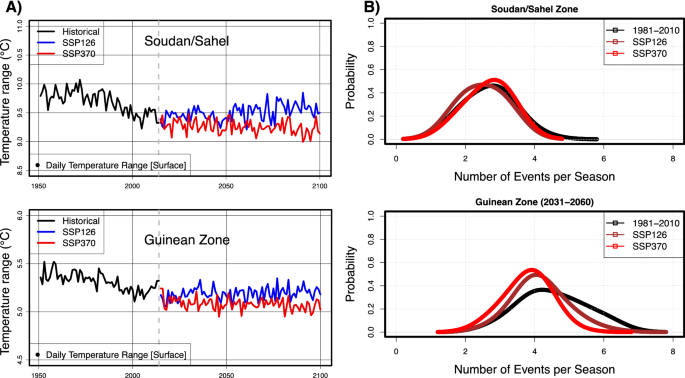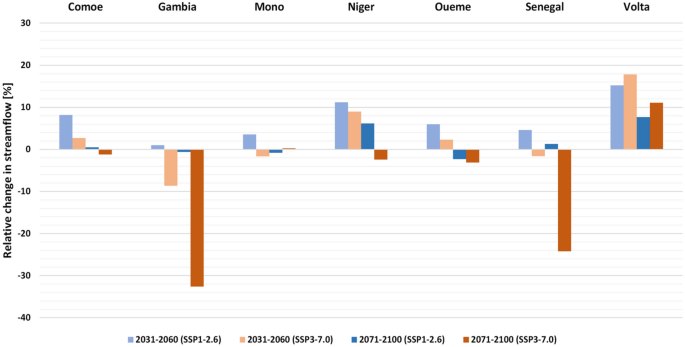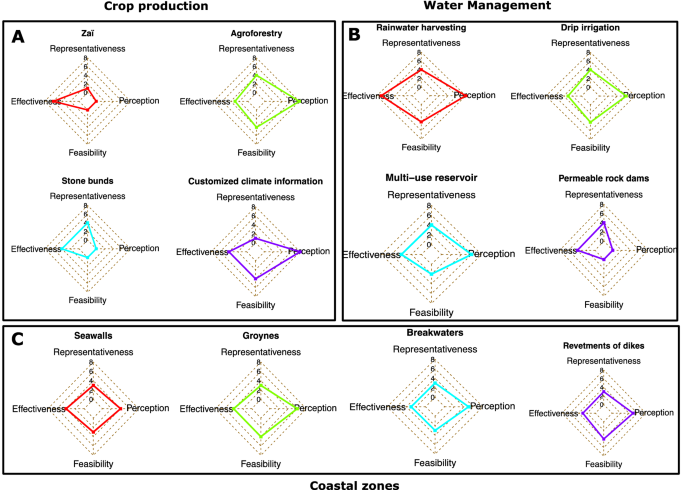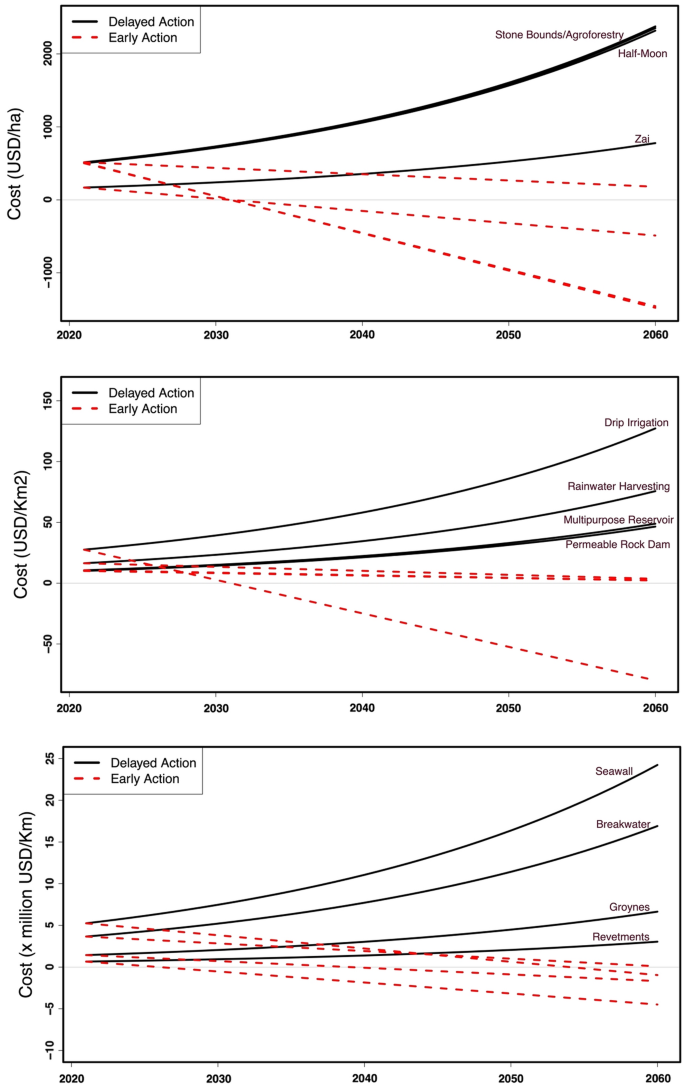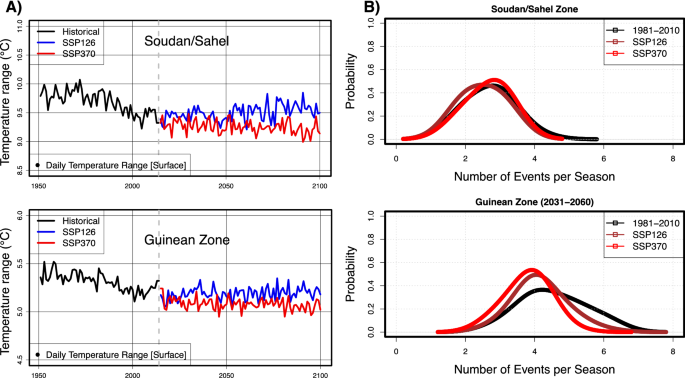
[ad_1]
Pluviometric and thermal extremes
Historic and ongoing developments of the West African local weather point out progressive warming, altering traits, and sophisticated climate patterns depicted by near-surface in situ measurements, satellite tv for pc observations, human perceptions, and local weather mannequin simulations3,12,25. Topic to regional warming, the West African Monsoon (WAM) system creates hotspots of maximum climate occasions alongside the shoreline, residence to densely populated, low-lying cities and financial hubs alongside the arid/semi-arid areas4,5,25. Because of this, there was a reducing development within the variety of cool nights and extra frequent heat days, heat nights, and warmth waves25. On the native scale of the Soudan/Sahel subregions, a brand new sample of rainfall regime has emerged because the Nineties, characterised by a combination of pluviometric extremes throughout single wet seasons, together with false onsets and early cessation of cropping seasons, heavy rain occasions, and lengthy dry spells4,5. Alongside the Guinean zone, the noticed stationarity of the rainfall regime could be attributed to a extra intense second wet season, related to a late withdrawal of rains and with extra important interannual variability of rainfal26.
Evaluation of state-of-the-art local weather change situations reveals that temperature will proceed rising, the diurnal temperature vary (DTR) will proceed to scale back (Fig. 1A), with a rise in common air temperatures (Supplementary Fig. S2a), and an elevated frequency of warmth extremes resembling scorching days and sizzling nights25. It’s nicely established that prime nighttime temperatures considerably affect crop manufacturing by reducing photosynthetic operate, sugar, and starch content material, rising respiration fee, suppressing floral improvement, and accelerating crop maturity31. These findings are in line with earlier assessments primarily based on international and regionally downscaled local weather mannequin output27,69,108. A consensus can be observable within the area’s common rainfall improve and extra excessive climate situations. The Soudan/Sahel zone will seemingly expertise an general improve in common rainfall inside 10% to twenty% or extra, albeit with a lower, with a spatial dipole configuration in its western subregions overlaying Senegal, The Gambia, and Guinea-Bissau.
(A) Interannual variability and traits of the every day common temperature vary (DTR) primarily based on the near-surface temperature depicted within the Soudan/Sahel and Guinean zones of West Africa. The 1950–2014 collection relies on observations combining in situ and gridded information. Projections over 2015–2100 are derived from the shared socioeconomic pathways SSP126 & SSP370 situation utilizing 5 bias-corrected and downscaled international circulation fashions from the intersectoral affect intercomparison mission (ISIMIP3b). (B) Common seasonal distribution of heavy rain occasions (HRE) through the 2031–2060 horizon over the climatic zones of West Africa.
Quite the opposite, the Guinean zone will seemingly expertise a quasi-stationary rainfall regime (Supplementary Fig. S2b). This sample, corroborated in earlier assessments28,29, can be observable within the newest simulations of CMIP6 fashions27,30. Each day rainfall occasions are prone to develop into extra intense however much less frequent together with longer intraseasonal dry spells (Fig. 1B), inflicting different agroclimatic extremes and compound occasions like false onset and early cessation of cropping seasons, shorter cropping season, farm inundation, droughts, and warmth stress for staple crops (e.g., Millet, maize, sorghum, cowpea, and tubers). As well as, floods related to heavy rain occasions and enormous storms (stronger wind gusts) will develop into extra widespread. Moreover, SSP126 and SSP370 present that agricultural droughts are extra frequent with no clear spatial sample on the time horizons of 2031–2060 and 2071–2100 (Supplementary Fig. S3). This combined dry/moist sample of the rainfall regime was attributed to international warming by means of inner variability of the dynamic components of the regional environment and the warming of the ocean floor temperature31. On the identical time, the dominance of greenhouse gases explains future projections of wetter situations within the Soudan/Sahel zone32. Many different weather-related dangers are related to temperature extremes, though different local weather variables resembling rainfall, wind gusts, radiation, and humidity compound the challenges.
Wants for adaptation in crop, livestock, and fishery manufacturing techniques
In response to the consensus of situations, with out adaptation measures a variety of adjustments in cereal yield is reported, with an general common yield discount erratically distributed over a area for grains (e.g., pearl millet, sorghum, maize, and rice), tubers and root crops, groundnuts, cowpea, soybeans, and cotton beneath completely different rainfall regimes (Supplementary Fig. S4). From Supplementary Fig. S4, pearl millet is much less delicate to warming charges under two levels amongst cereals, partly attributable to its strong coping capability in opposed situations. For rice varieties, whose development cycle is assumed to be invariant over the precise and projected future wants, a slight improve in yield of about + 9% may very well be noticed. Nevertheless, for circumstances the place a shortening of the rising cycle induced by greater temperatures is accounted for, decreases in yield may attain − 42% relative to reference durations33. Yam manufacturing can be anticipated to lower by 28% for each 1 °C improve, as a result of warming contributes to the proliferation of pests and illnesses, affecting yam development, improvement, and manufacturing34,35.
In the meantime, cassava is much less negatively impacted by local weather change (− 3.7% to + 17.5%) as it’s tolerant to drought and isn’t simply broken by heavy rains36. Nevertheless, floods had been discovered to be detrimental to cassava yields. There’s an inverse relationship between cassava yield and local weather parameters with a major unfavourable impact of accelerating most temperature. Typically, soybeans and groundnuts are much less affected by rising temperatures, since photoperiod sensitivity limits the length of crop improvement and the CO2 fertilization37. By the top of the century greater than 60% of bean-growing areas must transition to different crops and legumes (e.g., soybean and groundnut), representing promising agribusiness alternatives beneath local weather change38. Future areas appropriate for rising crops are relocated to the Soudan-Savanna for groundnuts and maize, whereas millet and sorghum stay relevant throughout all agroecological zones. Cotton manufacturing advantages primarily from chemical fertilizers distributed by nationwide cotton firms and favored by personal sector investments. When built-in soil-crop administration and excessive mineral fertilizer ranges are used, future cotton productiveness is predicted to extend barely, by roughly + 7 to + 31% in all future local weather change situations39,40. Nevertheless, massive quantities of rainfall through the germination stage are unfavorable for cottonseeds, and rainfall variations through the maturity stage may considerably have an effect on yield40.
Due to this fact, water availability and the predictability of essential components such because the onset, length, and cessation of wet seasons will probably be essential for cotton manufacturing in West Africa. Giant components of manufacturing areas will develop into unsuitable for farming sooner or later and might want to be transformed41. This highlights a robust differentiation of local weather vulnerability throughout the cocoa belt, for instance, as areas within the western, central, and jap areas will seemingly develop into hotter and wetter41,42. Probably the most weak areas are close to the forest-savanna transition in Nigeria and jap Côte d’Ivoire. Quite the opposite, the least weak areas are in southern components of Ghana, Côte d’Ivoire, and Liberia42,43. Curiously, cashew and shea nut timber will seemingly be strained by dynamic local weather change components (e.g., elevated frequency and depth of winds, intense rainfall, improve in temperature) and unfavorable illnesses44,45,46.
The change will negatively have an effect on livestock by means of the impacts of warmth stress on animal efficiency47, water availability, high quality, pastoral assets8,48,49, reproductive efficiency, milk, and meat manufacturing48,50, livestock mobility (i.e., redistribution of pastures and corridors), and animal illnesses49,50. The size of consecutive days of warmth stress for dairy cattle, with intensities greater than extreme and harmful thresholds, is prone to improve (Supplementary Fig. S5). Beneath future local weather situations, the typical size of durations with excessive and harmful warmth stress is predicted to develop from ~ 3 days within the historic interval to ~ 4–7 days by 2021–2050 and even to as much as 10 days by 2071–2100. Round 22% of the dairy cattle inhabitants can be anticipated to expertise roughly 70 days of extra extreme/harmful warmth stress, particularly within the southern half of West Africa50. Due to this fact, important decreases in productive and reproductive efficiency will probably be inside − 22% relative to the 1981–2010 baseline. Thus, the interplay between transhumant herders and host communities intensifies competitors over pure assets (e.g., transhumance corridors), triggering conflicts ensuing from warmth stress and water availability attributable to local weather extremes.
Inland fisheries and aquaculture will even be not directly affected by local weather change by means of the depletion of assets in water our bodies, the proliferation of parasites and ichthyotoxic crops19,20,51, inundation, and salinization of land and coastal freshwater because of the rise of sea stage (SLR), rising the frequency of floods, storms, and storm surge anticipated in riparian and coastal zones51.
Wants for adaptation in hydrology and water assets administration
Local weather change is predicted to affect river basins and water provide techniques considerably. Floods related to intense rainfall have develop into extra widespread within the area because the Nineties, with substantial human insecurity, together with harm to manufacturing, communication, transport techniques, and well being and livelihoods3,12. Moreover, the projected demographic stress in West Africa (~ 800 million estimated inhabitants by 2050) will improve demand, pose substantial threats to water safety2, and considerably modify hydrological regimes and pure ecosystems. The principle rivers within the area confirmed minor adjustments in discharge on a regional scale, with median outcomes (completely different time horizons, situations, and fashions thought of) throughout the vary of ± 5%52,53,54 (Supplementary Fig. S7). On the basin scale, all main rivers present an rising development in floor circulation52,55, apart from the Gambia and Senegal river basins, which exhibit a major unfavourable development of 8–16% and 22–26%, respectively, in line with the drying sample projected for precipitation on this subregion (Fig. 2). The general relative change sign in most basins is an erratically distributed relative change sign with optimistic and unfavourable values. This reverse tendency was partly attributed to the structural uncertainty of the hydrological fashions54 and the reference interval used56. Different rivers within the area usually current insignificant median relative adjustments in discharge, implying that the affect of local weather change is small or not exact, even when it may probably be sturdy in some circumstances (Fig. 2). Nevertheless, on an area scale, the outcomes spotlight zonal contrasts in median runoff adjustments between the western (dry) and jap (moist) Sahel and between the north (and extra sturdy decreases in discharge) and the southwest (pronounced will increase) areas of West Africa (Supplementary Fig. S8). Most basins are experiencing flood occasions with magnitudes anticipated to extend, with alarming extremes attributable to excessive sensitivity to climatic and land use adjustments, improper dam administration57,58, and settlements in flood-prone areas59,60.
Due to this fact, water sanitation and hygiene (WASH) could be affected by many types of water air pollution, resembling salinization of groundwater, intrusion of sediments, natural carbon, pathogens, and pesticides that can considerably have an effect on populations60,61,62. Groundwater, which typically contributes to assuaging the specter of local weather change on water availability, could spotlight a lower in high quality, particularly for unconfined shallow aquifers that supply little or no attenuation to contaminants from the polluted floor beneath flooded rivers and lagoons. Though simulated adjustments recommend that the typical recharge of groundwater storage within the central Soudan/Sahel zone could improve by the 2050s, within the western coastal areas important decreases are predicted63,64. Nevertheless, there isn’t a clear development on the affect of local weather change on the protection of consuming water provide for home/municipalities as a result of groundwater contributes, in some circumstances, to scale back threats. Irrigation water wants are projected to extend by 15% to 30% relying on the basins by 2050 as nicely63,64. The lower in river discharge and the rise in evapotranspiration related to international warming may pose a extreme menace to hydropower65,66,67. The event of infrastructure in river basins usually entails buying and selling off competing goals in an unsure surroundings with many transboundary and nexus points that have to be nicely built-in and managed accordingly66,67.
Potential impacts on the coastal zones
West African coastal areas, coastlines, and littorals are uncovered to adjustments in ocean parameters resembling sea floor warming, sea stage rise, wave peak, ocean acidification, flooding, and erosion21,68. Estimates of ocean warming alongside the coasts can vary between 1.5–2.5 °C and 1-3.2 °C from mid to the top of the twenty-first Century. From Sierra Leone to Guinea-Bissau, the West Coast is uncovered to swell ocean waves from the north and south Atlantic which are low to reasonable power69. The long run change within the annual important wave heights (Hs) is extra necessary within the Guinean coastal nations within the close to time period, and a considerable lower in Hs is projected over the long run. Sea stage rise (SLR) threatens West African coastal communities. It’s linked to coastal hazards resembling storm surges, flooding of low-lying areas, coastal erosion, and harm to coastal infrastructure and ecosystems70,71.
SLR is the primary issue affecting coastal vulnerability, estimated to be reasonable to very excessive in some research areas71,72. Modifications in ocean chemistry are dominated by ocean acidification, which is oxygen depletion or deoxygenation21,73. Nevertheless, attributable to important uncertainties in potential biogeochemical results and in the evolution of tropical ocean dynamics, there’s a lack of consensus on the longer term quantity of oxygen-poor waters74. Coastal marine ecosystems (for instance, mangroves) and fishing are already affected. They’ll proceed to be involved sooner or later, as will increase in ocean warming and weakening of the upwelling attributable to unfavorable wind at some areas could result in critical rippling results on the productiveness of small pelagic fish species75,76,77. Due to this fact, the utmost catch potential of fish shares is projected to say no by greater than 50% by the 2050s, with probably the most important reductions in nations close to the equator, apart from nations like Cabo Verde, Gambia, and Senegal78. Given the SLR charges and the longer term predicted shoreline vulnerability calculations (Supplementary Fig. S9), West African mangroves will face the specter of being utterly inundated ought to sea ranges rise past the degrees they’ll deal with (Supplementary Word 2 and Supplementary Fig. S10).
Prices of inaction, early, and delayed actions on adaptation
Current studies present adaptation prices at international and regional ranges, together with an evaluation of adaptation finance gaps in Sub-Saharan Africa23. The very best adaptation prices are projected to be wanted within the water provide, coastal zone safety, infrastructure, and agriculture sectors6,23,24. The practices fitted to and deemed sustainable relative to the longer term West African local weather are scored and ranked in line with the practitioners’ suitability, effectiveness, feasibility, representativeness, and perceptions (Tables 1 and 2). The very best-scoring adaptation choices are given in Fig. 3, with significantly better perceptions by the native populations, ease implementation (excessive feasibility), and obvious effectiveness and representativeness in line with a S.W.O.T-based evaluation. Because the impacts of local weather change can also alter and shift the worldwide cultivation space of varied crops, the extent of the water physique and coastlines24, the estimation of prices is expressed within the satisfactory commonplace unit (e.g., Hectare, Cubic meter, or Kilometer) helpful for interpolations on a lot bigger scales (e.g., countrywide, basin-scale, regional, and so on.). Estimating adaptation choices in agriculture, water assets, and coastal zones are categorised into ‘prices of inaction’ and the prices related to implementation, generally known as ‘prices of motion.’ The latter consists of utilizing the present market prices of comparable choices after which adjusting them to mirror market costs over time, contemplating melancholy, low cost charges, curiosity, and projected inflation charges79.
Crop manufacturing
The impacts associated to local weather change on crop manufacturing range in line with crop sorts, local weather change situations, and timelines. The prices of motion/inaction range relying on adaptation choices. When early measures are carried out to help crop administration, the mission value is predicted to scale back shortly after implementation. Three classes of crops are investigated, specifically cereals (for instance, rice, maize, millet, sorghum), tubers and root crops (for instance, Yam and cassava), and money crops (for instance, peanuts/corn). For crop manufacturing, the present implementation of agroforestry will value USD514.9 per hectare (/ha), adopted by stone bunds (USD509.77/ha), and at last, small-scale adaptation choices (USD168.5/ha) (e.g., Zai strategies, Mulching, and so on.), that are particular to the semi-arid zones. Going the “Rocky Street” (i.e., SSP370 situation), preliminary inaction prices in crop manufacturing are estimated to be USD575.44/ha, and the estimate for the SSP126 methodology will quantity to USD392.78/ha by the 2050s. Crop manufacturing losses are greater for tuber & root crops (e.g., yam) than money crops (e.g., peanuts) and cereals. The price of inaction in crop manufacturing is predicted to soar shortly, with a bigger uncertainty spectrum discovered within the SSP370 situation (Supplementary Fig. S11). On account of preliminary funding prices, motion prices seem extra elevated than inaction prices. Nevertheless, they’ll develop into inadequate when contemplating depreciation, representing 13–20% of the preliminary prices relying on the kind of adaptation possibility (Fig. 4).
Livestock and transhumance
Transhumance is a livestock manufacturing system characterised by common seasonal actions between complementary ecological zones beneath the care of some herders. This breeding methodology generates conflicts between farmers in host nations and transhumant herders attributable to stress on shared water and pure assets7,48. A number of insurance policies and legal guidelines have emerged within the completely different states of the West African area to scale back or stop farmer-herder conflicts and promote sustainable transhumance. Nevertheless, the operationalization of those texts isn’t but a actuality47. Projected local weather excessive occasions will seemingly intensify transhumance within the subregion the place some nations resembling Benin, the Ivory Coast, Togo, and Ghana have develop into host or transit nations7,8,47. Due to this fact, within the medium and long run, adaptation choices within the livestock sector will require an progressive authorized framework and the applying of laws by which multistakeholder platforms will probably be established for collaboration and consultations amongst livestock sector actors (e.g., herders, farmers, administrative authorities, native conventional rulers, land homeowners, researchers, and so on.). Suggestions for an environment friendly authorized framework for the sustainable administration of transhumance are offered in Supplementary Desk S2. For sustainable grazing areas and corridors, items and companies might have solely USD18,693.37 to construct a 250-ha reference-protected reserve. Nevertheless, the proper implementation of the authorized framework, the monitoring, analysis, and administration system have to be carried out to help rural improvement, scale back conflicts and enhance the apply of transhumance and elevating livestock (Supplementary Desk S2).
Water assets and coastal zones
The losses and damages within the water assets sector are estimated at USD7.7 per cubic meter. Implementing multiuse reservoirs will value solely USD1.6 per cubic meter. The adoption of rainwater harvesting will value USD2852.8 per hectare of crops, whereas drip irrigation and permeable rock dams will value USD2756.0 and USD300.7, respectively. In coastal areas of West Africa, floods usually lead to appreciable materials loss and damages (e.g., harm to crops, destruction of homes, bridges, and so on.). To stop accidents or scale back results, investing in seawalls, breakwaters, revetments, and groins will value USD 5,250,000.0/km, USD 3,663,003.0/km USD 1,440,000/km, and USD 650,000/km, respectively. Funding prices re diminished (i.e., USD262,500, USD91,575, USD36,000, and USD26,400 per km, respectively) when contemplating depreciation, which corresponds to solely 8–11% per yr of the price of inaction. The estimated value of inaction will probably be USD 3,164,020 per km (Supplementary Desk S1 and Fig. 4).
With more and more recurring and projected hydrometeorological hazards, the rising consumer wants for climate, local weather, and environmental companies, the capability requirements of the nationwide businesses answerable for early warning, civil safety, and catastrophe administration have to be improved to make nations weather-ready nations6,80,81. In 1–5 years, the funding wanted was estimated at 3.4–6.9 million US {dollars} relative to the scenario in 2019/2020 to cowl everlasting workers coaching and capability constructing, small equipment to enhance the working surroundings (e.g., web connection, complimentary electrical energy provide to cowl intermittent energy, substitute or restore computer systems/{hardware}), and information and data administration networks in West African nations. The Hydromet Initiative6 (https://www.worldbank.org/en/applications/africa_hydromet_program) elaborated additional funding prices to modernize nationwide and regional organizations to regularly enhance and maintain service high quality. The funding wants had been estimated at USD 324.5 million (together with USD290 million for the member states and USD34.5 million in help of regional establishments), contemplating out there value estimates from present initiatives in West Africa.
[ad_2]
Supply hyperlink
